
views
Storing Potted Fuchsias

Water the plants every 3-4 weeks starting in fall, then stop entirely. Once you start having cooler weather—typically around September in the Northern Hemisphere and March in the Southern Hemisphere—cut back so you're only watering your fuchsia plants every 3-4 weeks. Then, stop watering them altogether about 4-7 days before you plan to prepare them for overwintering. If the root ball is too wet, it will cause water droplets to gather at the places where you prune your plant, which can damage the fuchsia.

Watch for the first freeze so you'll know when to prepare your plants. To determine when you should cut your fuchsias for winter, check the Farmer's Almanac or a local gardening center to determine when to expect the first hard freeze of the year. However, it's important to keep an eye on your local weather forecast in case a freeze comes early. If that happens, prepare the plants before the cold weather begins. For instance, if you're overwintering fuchsias in the Pacific Northwest, and you live in Zone 10, your first frost would be expected between November 1 and November 10. In that case, it would be a good idea to prepare the plants during the last 1-2 weeks of October. If a freeze occurs unexpectedly, bring the plants inside until the freeze warning has passed, then overwinter them as normal.
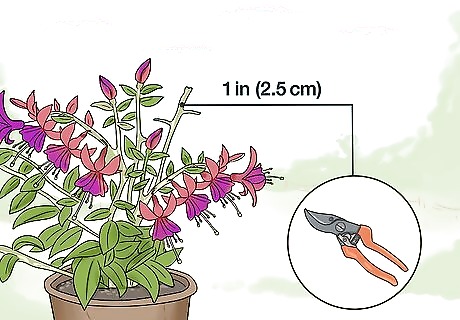
Prune back the plant by about 1/3, cutting 1 in (2.5 cm) above leaf joints. When you're ready to prune your plants, take a pair of cutting shears and wipe down the blades with rubbing alcohol to disinfect them. Then, trim off about 1/3 of the plant's branches. Each time you make a cut, ensure you snip at least 1 in (2.5 cm) above a leaf pair to encourage future growth. As you cut, focus especially on branches that extend past the perimeter of the pot or above the rest of the plant. To avoid potentially spreading disease or bacteria, disinfect the blades of your shears between plants if you'll be pruning multiple fuchsias. If you're planning to overwinter the plant in a dormant state, you can cut it all the way back, leaving about 3 in (7.6 cm) above the ground. However, if you'd prefer, it's still fine to only trim it down by about 1/3.
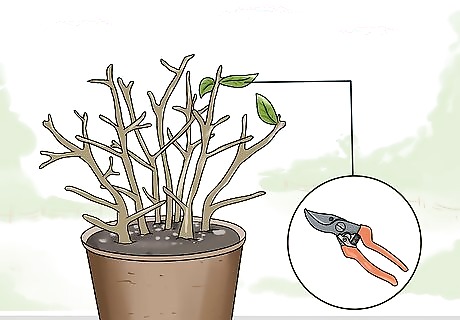
Cut any remaining leaves off of the plant. Use your garden shears or a sharp pair of scissors to snip away any leaves that are left on the plant. Don't worry—new leaves will grow in the spring! Tip: Some people prefer to trim the leaves off of the plant first before pruning the branches, as it allows them to see the shape of the plant more clearly. If your plant has already been through a frost, some or all of the leaves may have already fallen off. If so, just cut off any that are left.

Store older fuchsias between 34–36 °F (1–2 °C) to keep them dormant. Putting a plant into dormancy ensures that it won't grow at all, allowing it to conserve energy to grow more in the spring. To do that, keep it in a location that's cool, but not freezing, like a porch or a basement with a constant temperature of 34–36 °F (1–2 °C). This is a good option for plants that already have a well-established root system. It's okay if the temperature fluctuates higher during this time, although the roots and branches of the plant may grow a little if that does happen. However, if the temperature in the storage area is going to dip below freezing, bring the plants indoors or move them to another protected location.
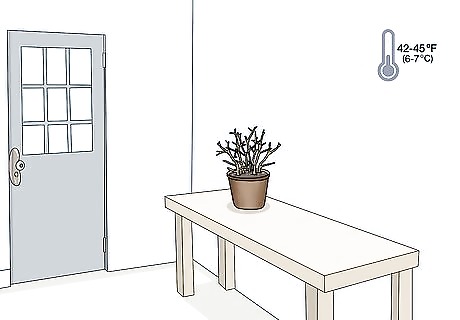
Keep younger plants semi-dormant by storing them between 42–45 °F (6–7 °C). Storing your plants in a semi-dormant state is a gentler way to overwinter them, so it's a good option for younger plants that haven't had as much time to develop a strong root system. The best way to keep your fuchsias semi-dormant is to keep them in a greenhouse with a steady temperature of 42–45 °F (6–7 °C), although if you have a warmer cellar or enclosed porch, that could work too. Avoid letting your fuchsias get much warmer than that, or they'll start to grow leggy, weak branches. You can store the plants upright, but if you have the space, consider laying them on their side to promote better root growth.
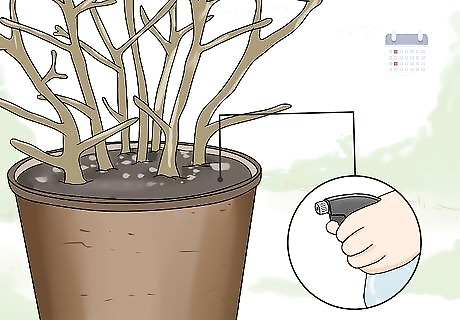
Mist your plants every 2-4 weeks to keep the root ball moist. When you're overwintering plants, they can easily die if they get too much or too little water. To avoid this, mist the soil lightly every 2 weeks or so, although you can wait up to 4 weeks if the soil is still moist to the touch. Do not soak the plants, but do make sure the earth is thoroughly damp. If you'd like to encourage more root growth, you can mix a diluted fertilizer in with your water. However, this isn't necessary, and you should take care not to over fertilize the plant, since it's outside of the normal growing season.
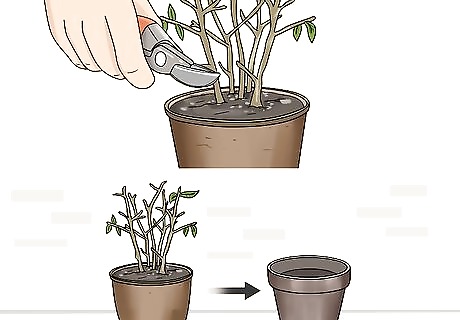
Prune and repot your plants in the spring. After the danger of frost has passed, examine your plants and prune away any dead growth that might have developed during the overwintering process. Then, remove the fuchsia from its pot, replace the compost, and gently place the plant back into its container. Pruning the plant again will help encourage new growth.
Protecting Established In-Ground Fuchsias
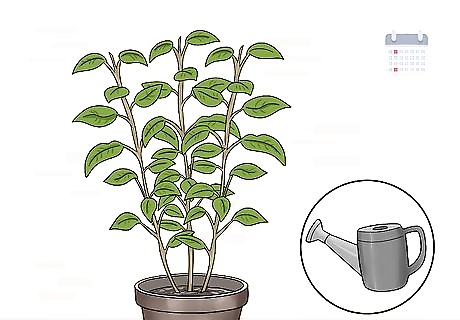
Water the plant every 3-4 weeks starting in the fall. To give your hardy fuchsias the winter care they'll need to make it another year, start preparing as soon as the temperatures start to cool. At the beginning of fall (September in the Northern Hemisphere or May in the Southern Hemisphere), cut back how often you water your fuchsia plants to about once every 3-4 weeks. Too much water will cause your plants to die back during the overwintering process.
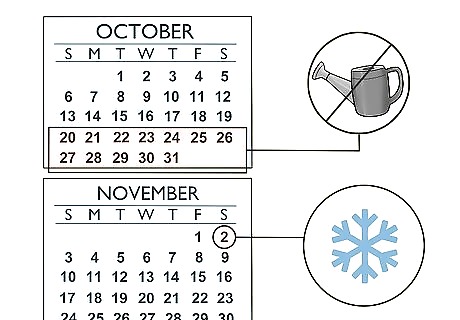
Stop watering the plant entirely two weeks before the first freeze of the year. Check your local news and weather stations or the Farmer's Almanac to determine when the first hard freeze is expected in your area. It's a good idea to overwinter the plants about a week before this date, so you may want to stop watering them entirely about two weeks before that. For instance, if the date of your expected first freeze is November 2, you might plan to prepare the plants on October 26. In that case, you wouldn't want to water them later than October 19 to give the roots time to dry out. Be sure to keep an eye on the forecast in case a freeze happens earlier than expected.
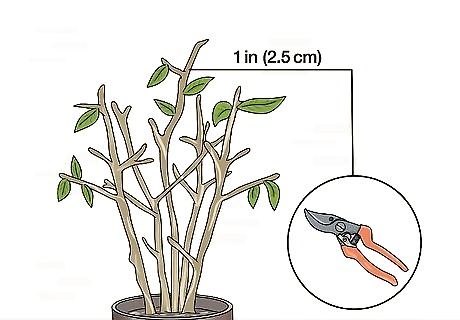
Prune away any long branches, cutting 1 in (2.5 cm) above leaf joints. Look for any branches that extend beyond the basic shape of your fuchsia plant. When you find one you want to cut, locate a leaf pair, then use garden shears to cut about 1 in (2.5 cm) above this joint. When you're preparing a plant to overwinter in the ground, it's important that you don't prune it back too hard. Much of the growth that's left will die back during the winter, but it will help insulate the plant from the cold. If you're pruning multiple fuchsia plants, disinfect the blades by wiping them down with rubbing alcohol between plants.

Snip off any remaining leaves. Use your garden shears or a pair of scissors to trim off any leaves that are left. Cut as close to branch as you can. This will help the plant conserve the energy it needs to get through the winter.
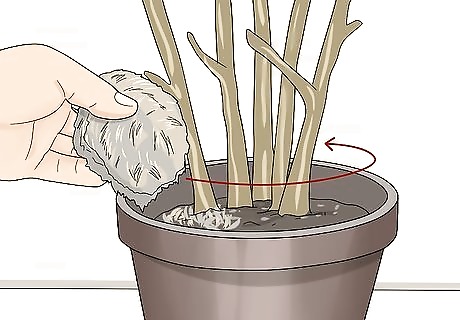
Place 1–2 in (2.5–5.1 cm) of mulch around the base of the plants. In order to insulate your hardy fuchsia plants from the cold, put a generous layer of mulch around the trunk of the plant, extending out about as far as the root ball would reach. You can use straw, leaves, grass cuttings, bark, or compost as mulch. If you're not sure how large the root ball is, make a circle extending about 2 ft (0.61 m) from the center of the plant. Check the mulch periodically throughout the winter to ensure it hasn't been disturbed by wind, birds, or small animals.

Cut back any dead branches in the spring. Once the danger of the last freeze has passed, examine your plant and use your garden shears to cut off any branches which look dead or wilted. If it was a very cold winter, you may have to cut the plant almost all the way back, but avoid cutting the main branch shorter than 3 in (7.6 cm). If you're not sure if a branch is dead, scrape away the bark. If the inside of the branch is green, it's still alive. If it's brown, the branch is dead.

















Comments
0 comment